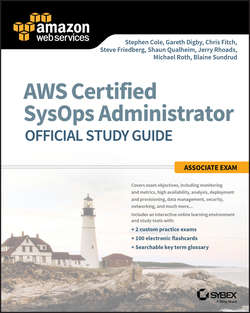Читать книгу AWS Certified SysOps Administrator Official Study Guide - Cole Stephen - Страница 9
На сайте Литреса книга снята с продажи.
Assessment Test
Answers to the Assessment Test
Оглавление1. C. Instance Status monitors the software and hardware of your individual instance. The other items listed are issues that affect the underlying AWS hardware.
2. B. The route table in the Public Subnet has a route pointing to the IGW. IGWs are associated with VPCs, not with subnets. Elastic Load Balancers can be in both the Public Subnet and the Private Subnet.
3. A. By default, the load balancer distributes traffic evenly across the Availability Zones that you enable for your load balancer. To distribute traffic evenly across all registered instances in all enabled Availability Zones, enable cross-zone load balancing on your load balancer. However, it is still recommended that you maintain approximately equivalent numbers of instances in each Availability Zone for better fault tolerance.
4. C. If you don’t specify a preferred maintenance window when you create the DB instance or DB cluster, then Amazon RDS assigns a 30-minute maintenance window on a randomly selected day of the week.
5. A. You are responsible for security in the cloud, which includes configuring and applying Security Groups to resources running within the customer’s account.
6. C. Amazon Simple Storage Service (Amazon S3) provides a low-cost method of storing objects in a highly available and durable manner.
7. D. You can choose up to a maximum of 16 TB per Amazon EBS volume, so you must create a RAID array of multiple volumes to achieve the IOPS being sought.
8. A. User data is run at boot time and can be used to install software. The other answers listed are examples of metadata, which is associated with the Amazon EC2 instance and can be accessed via the Amazon EC2 metadata service.
9. C. Subnets of a VPC have to be in the same address space as the VPC itself.
10. C. You can use scaling policies to increase or decrease the number of running Amazon EC2 instances in your group automatically to meet changing conditions. When the scaling policy is in effect, the Auto Scaling group adjusts the desired capacity of the group and launches or terminates the instances as needed. If you manually scale or scale on a schedule, you must adjust the desired capacity of the group in order for the changes to take effect.
11. D. Amazon RDS connection strings are based on Amazon Route 53 DNS. Inside Amazon RDS, they are referred to as endpoints. Endpoints include both the DNS name and the port number for the database instance.
12. A. Amazon EBS volumes must reside within the same Availability Zone (AZ) as the instance to which you are attaching the volume.
13. A. You can create an Amazon Aurora Read Replica to sync data from an Amazon RDS for MySQL source. By failing over to the replica, you can efficiently migrate between databases. Use a manual snapshot to pre-populate the read replica.
14. B. An Amazon RDS instance in a Multi-AZ deployment will automatically fail from a failed primary node to the standby node.
15. D. An Amazon DynamoDB database is replicated across three facilities in an AWS Region automatically.
16. C. Amazon ElastiCache provides an in-memory cache that can cache frequently read data and alleviate common read queries from hitting your database layer.
17. A. Elastic IPs are associated with the account, not the Amazon EC2 instance. However, unassigned Elastic IPs incur a charge. This is to discourage hoarding of IP addresses.
18. B. IAM should not be used because content will be accessed by individuals who do not have an IAM account. The LIST Distribution API just lists distributions; it does not control access. Origin Access Identity (OAI) is how you control access to content in an Amazon S3 object, not an Amazon CloudFront Distribution.
19. C. Amazon DynamoDB does not support the AWS Key Management Service (AWS KMS) nor server-side encryption. You can use customer-side encryption to store encrypted data in Amazon DynamoDB.
20. A. Amazon DynamoDB is a fast and flexible NoSQL database service for all applications that need consistent, single-digit millisecond latency at any scale. It is fully managed, and it supports both document and key-value store models.
21. D. Amazon SQS provides a scalable message queueing service, which allows the operator to avoid the undifferentiated heavy lifting associated with running a traditional message queuing application.
22. D. AWS Direct Connect uses the VPN Gateway as the gateway to the VPC. You can create a VPC that only has a VPN Gateway attached to it.
23. C. You can configure health checks, which are used to monitor the health of the registered instances so that the load balancer can send requests only to the healthy instances.
24. B. When you use Auto Scaling to scale your applications automatically, it is useful to know when Auto Scaling is launching or terminating the Amazon EC2 instances in your Auto Scaling group. Amazon SNS coordinates and manages the delivery or sending of notifications to subscribing clients or endpoints. You can configure Auto Scaling to send a SNS notification whenever your Auto Scaling group scales. AWS Lambda blocks port 25, the SMTP port, therefore it is not possible to send emails with Lambda.
25. A. Spot instances provide you with access to unused Amazon EC2 capacity at steep discounts relative to On-Demand prices. The Spot price fluctuates based on the supply and demand of available unused EC2 capacity.
